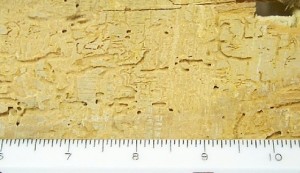Powderpost Beetle Damage – Views of Infected Wood
Powderpost beetles are only about 1/8 inch long, they spend most of their lives in the larval state hidden in the wood they are infesting, and emerge at night only for a few days before they breed, lay new eggs, then die.
The common element here is that it’s hard to see the beetles themselves. Most likely, you’ll only see the evidence of their presence. And that evidence will be the small pin-head sized exit holes they bore when the powderpost beetle larvae matures into an adult and exits the wood to breed.
To help you diagnose the signs of powderpost beetle damage to wood, we’ve provided the following images.
Powderpost Beetle Damage to a Window Frame
 Credits: Wood Beetles, Powderpost Beetles and How to Treat Infestations …
Credits: Wood Beetles, Powderpost Beetles and How to Treat Infestations …
Powderpost Beetle Damage to a 2X4 Piece of Lumber
 Credits: Wood Beetles, Powderpost Beetles and How to Treat Infestations …
Credits: Wood Beetles, Powderpost Beetles and How to Treat Infestations …
Powderpost Beetle Damage to Wood Paneling Front and Back
 Credits: Wood Beetles, Powderpost Beetles and How to Treat Infestations …
Credits: Wood Beetles, Powderpost Beetles and How to Treat Infestations …
 Credits: Wood Beetles, Powderpost Beetles and How to Treat Infestations …
Credits: Wood Beetles, Powderpost Beetles and How to Treat Infestations …
Powderpost beetle damage is done by the larvae which lives and tunnels in the wood, consuming fungus which has been deposited by the adult along with the eggs. It’s the fungus that actually breaks down the wood making it available for the powderpost beetle to digest.
The powderpost beetle eggs can exist in wood for as much as ten years before hatching, maturing larvae emerge as adults, so these pests can be extremely hard to detect.
Failure to detect and exterminate powderpost beetles can result in wood that literally crumbles into dust in your hands. If that wood is supporting the structure of your home, it’s not hard to imagine a scenario of total destruction and a plummet in resell value.
Successful extermination may require a penetrating product with a long residual, available only to a licensed pest professional.
Call ApolloX Pest Control
(888) 499-7378
We’re licensed, professional powderpost beetle exterminators.
Powderpost Beetle Damage – Susceptible Wooden Structures
Powderpost Beetle Damage to Log Homes
New log homes, even with treated logs, can still be infested, and the hidden infestation may not become apparent until up to 10 years after construction!
Powderpost Beetle Damage to House Siding
Exterior siding made of cedar, pine or some other wood can be infested with powderpost beetles. Watch for the pin hole exit marks on the wood. You may need to remove and treat or replace the siding depending on the extent of the damage. You’ll also want to thoroughly inspect the underlying wood. If that is also infected and untreated, your new or treated siding will likely be reinfected.
The rule here is to treat a much larger area than the area where you see the exit pinholes. Treat all surrounding wood.
Powderpost Beetle Damage to Attics
Rafters, floor joists and studs can be infected by powderpost beetles, and the damage may lie hidden for years following the construction of the home.
Powderpost Beetle Damage Inside Walls
When remodeling, inspect inside the voids above crawl spaces and below attics for powderpost beetle damage. You’ll need to remove sheet rock and paneling.
Powderpost Beetle Damage to Crawl Spaces
The first line of defense here is to ventilate all crawl spaces since powderpost beetles love moist wood. This action alone may cause the powderpost beetles to stop breeding and eventually exit your home. However, you will also want to treat the wood. Fumigation may be the preferred solution here. Note that only a licensed pest exterminator is permitted to purchase and apply the product needed.
Powderpost Beetle Damage to Furniture and Cabinets
Most often the powderpost beetle eggs or larvae were already inside the wood at the time of construction. In question here are picture frames, artwork, wall units, desks, couches, statues, cabinets, chairs and tables.
Take immediate action if you discover wood with the powderpost beetle exit pinholes. You may need to strip finished furniture in order to successfully apply wood-penetrating treatment.
Powderpost Beetle Damage to Antiques
Here’s the scenario: The furniture came from a powderpost beetle infested home or antique shop and is itself infested. Or, the furniture was imported and had been in contact with powderpost beetle infested wood. Even refinishing that old antique dresser won’t eliminate the larvae deep within. They’ll continue to tunnel about, the eventually exit the wood and infest your home! Always check for exit pinholes before bringing any wooden object into your home.
Powderpost Beetle Damage to Wooden Floors
The scenario here is a new oak floor is installed and varnished. Then, 1-5 years later the tale-tale powderpost beetle exit pinholes begin to appear, along with a fine dust powder at the exit hole. It’s most likely that the beetle problem existed in the flooring before it was installed in your home, and also likely that the manufacturer will deny this and tell you the infestation came from your home. They’ll also tell you that the infestation will die off, so just ignore it. Don’t believe this. You’ll need to treat the problem or risk the spread of infestation to your wooden furniture and even the framework and siding of your home!
We recommend stripping the entire floor and treating it with a penetrating powderpost beetle treatment. Failure to do this could mean replacing the floor at a far greater expense in a few years and potentially needing to treat all your wooden furniture and possibly your entire home. That would be a much much larger expense.
In the event you decide to replace the entire floor (the flooring manufacturer accepts responsibility and foots the bill), you might want to treat the new floor before finishing it. This will help ensure there will be no new powderpost beetle problems.
Powderpost Beetle Damage – How long might it persist following treatment?
Most powderpost beetle treatments are effective in killing the larvae. The treatment acts as a poison that activates when ingested by the larvae. The problem is that the pupae (the stage between larvae and adult) doesn’t eat. Neither does the adult. The pupae can exist in the wood for up to a year or more. When the pupae matures into an adult, it exits the wood, but since it doesn’t eat wood like the larvae, treatments are ineffective. The adult emerges, then looks for a mate, and for unfinished wood in which to lay a new batch of eggs.
As you can see, a powderpost beetle problem is very difficult to eradicate.
If you notice powderpost beetle pinholes in any wood in your home, it’s best to call a licensed pest control specialist.
Call ApolloX Pest Control
(888) 499-7378












Recent Comments